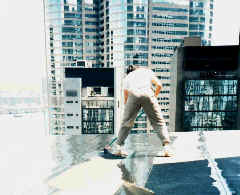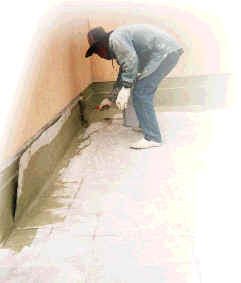

ROOF WATERPROOFING
Among the most basic and fundamental waterproofing works for a building are the roof and basement, nothing is more vital than a sound roof and a dry basement. Yet there is no single product that will provide an optimum solution to a whole waterproofing system and the selection of a waterproofing system is often made on the basis of cost against performance. Besides, to achieve predictable quality of the works, applicator's workmanship and ability to analyze the causes of the problem should be justified.
Broadly speaking, we only classify the resurfacing of the roof into two main categories which are the application of the materials on the concrete substrate directly or on the top of the flooring.
On Concrete Substrate
Taking the most common liquid applied polyurethane (PU)  waterproofing membrane for an example, the main
advantages are its direct adherence to the substrate that it forms a seamless membrane. In
case of its rupture, seepage is thus localized for easy maintenance. Anyway, the weakness
location to rupture is always on the construction joint and concrete crack that require
the membrane to bridge over. Elongation of the membrane seems to be a contributing factor
for bridging over the cracks but it should be considered in conjunction with the thickness
because there is an effect of a point shear force when compact floorings is laid on the
top of the membrane. As a result, special attention to even thickness should be paid and
it is accomplished with the fiber mesh to govern and strengthen the membrane especially on
angular locations. Moreover, concrete surface is not always smooth, PU waterproofing
membrane unlike sheet membrane can be fully accommodated to the substrate without worrying
about the air trapped that results in debonding to the substrate. In fact, substrate
preparation to repair crack and joint with epoxy injection and honey comb concrete with
cement additive mortar are also crucial for a durable waterproofing system.
waterproofing membrane for an example, the main
advantages are its direct adherence to the substrate that it forms a seamless membrane. In
case of its rupture, seepage is thus localized for easy maintenance. Anyway, the weakness
location to rupture is always on the construction joint and concrete crack that require
the membrane to bridge over. Elongation of the membrane seems to be a contributing factor
for bridging over the cracks but it should be considered in conjunction with the thickness
because there is an effect of a point shear force when compact floorings is laid on the
top of the membrane. As a result, special attention to even thickness should be paid and
it is accomplished with the fiber mesh to govern and strengthen the membrane especially on
angular locations. Moreover, concrete surface is not always smooth, PU waterproofing
membrane unlike sheet membrane can be fully accommodated to the substrate without worrying
about the air trapped that results in debonding to the substrate. In fact, substrate
preparation to repair crack and joint with epoxy injection and honey comb concrete with
cement additive mortar are also crucial for a durable waterproofing system.
On Top of the Flooring
Applying waterproofing membrane on the top of the flooring  is most
cost-effective method when floor finishing is not a big concern. However, once it is
ruptured, the leaking water will spread all over the floor to substrate eventually.
Quality performance of the membrane therefore depends on the toughness of the membrane
rather than the elasticity that accommodates the alleged movement of the substrate.
Since it is an exposed type waterproofing system and thus it is vulnerable to be damaged
by abrasion and puncture. Moreover, as the air trapped under the floorings have to
be expelled, the membrane will gradually detach from the floor surface and swells
everywhere as a result of air contraction and expansion every day. To tackle these
problems, seamless membrane for integrity with glass fiber mesh for reinforcement should
be introduced.
is most
cost-effective method when floor finishing is not a big concern. However, once it is
ruptured, the leaking water will spread all over the floor to substrate eventually.
Quality performance of the membrane therefore depends on the toughness of the membrane
rather than the elasticity that accommodates the alleged movement of the substrate.
Since it is an exposed type waterproofing system and thus it is vulnerable to be damaged
by abrasion and puncture. Moreover, as the air trapped under the floorings have to
be expelled, the membrane will gradually detach from the floor surface and swells
everywhere as a result of air contraction and expansion every day. To tackle these
problems, seamless membrane for integrity with glass fiber mesh for reinforcement should
be introduced.